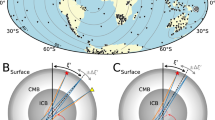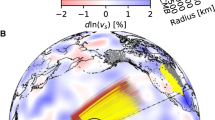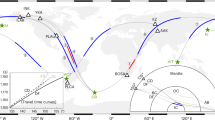Abstract
The core of the Earth is usually described by spherically-symmetrical velocity models. The core is made of two main spherical layers: the fluid outer core with a radius close to 3,480 km and a P-velocity increasing with depth from 8 km s−1 to 10.3 km s−1, and the solid inner core with a radius of 1,220 km and a P-velocity close to 11 km s−1 (refs 1, 2). Station residuals of the seismic core phase PKIKP have been computed for 400 seismological observatories worldwide using 5 yr of the International Seismological Centre (ISC) Bulletins. PKIKP travel times can be corrected for upper mantle propagation by subtracting P delays; thus PKIKP–P residuals are a measurement of the average vertical travel times in the lower mantle and in the core of the Earth beneath seismic stations. A spherical harmonic development of PKIKP–P delays up to degree 4 explains 58% of the variance in the data. PKIKP–P exhibit a latitudinal dependence: polar stations tend to be faster than equatorial stations. We show here that this pattern may reflect a departure from spherical symmetry in the P-velocity distribution in the vicinity of the inner core boundary of the Earth.
This is a preview of subscription content, access via your institution
Access options
Subscribe to this journal
Receive 51 print issues and online access
$199.00 per year
only $3.90 per issue
Buy this article
- Purchase on Springer Link
- Instant access to full article PDF
Prices may be subject to local taxes which are calculated during checkout
Similar content being viewed by others
References
Dziewonski, A. M. & Anderson, D. L. Phys. Earth planet. Inter. 25, 297 (1981).
Choy, G. L. & Cormier, V. F. Geophys. J.R. astr. Soc. 72, 1 (1983).
Jeffreys, H. & Bullen, K. E. British Association for the Advancement of Science (Gray Milne Trust, London, 1958).
Shimshoni, M. Geophys. J.R. astr. Soc. 13, 471 (1967).
Pillet, R. thesis, Univ. Grenoble (1979).
Adams, R. D. & Randall, M. J. Bull. seism. Soc. Am. 54, 1299 (1964).
Bolt, B. A. Bull. seism. Soc. Am. 54, 191 (1964).
Buchbinder, G. G. R. Bull. seism. Soc. Am. 61, 429 (1971).
Cleary, J. R. & Haddon, R. A. W. Nature 240, 549 (1972).
Jeffreys, H. Mon. Not. R. astr. Soc., Geophys. Suppl. 4, 548 (1939).
Hai, N. Ann. Geophys. 19, 285 (1963).
Agrawal, R. C. Geophys. J. R. astr. Soc. 53, 459 (1978).
Andersen, R. S. & Cleary, J. R. Phys. Earth planet. Inter. 23, 207 (1980).
Buchbinder, G. G. R. Bull. seism. Soc. Am. 64, 33 (1974).
Cleary, J. R. & Hales, A. J. geophys. Res. 76, 7249 (1971).
Bullen, K. E. An Introduction to the Theory of Seismology (Cambridge University Press, 1963).
Poupinet, G. Earth planet. Sci. Lett. 14, 149 (1979).
Dziewonski, A. M. EOS 63, 1035 (1982).
Engdahl, E. R. Science 161, 263 (1968).
Buchbinder, G. G. R. Earth planet. Sci. Lett. 14, 161 (1972).
Dorbath, C. C. r. hebd Séanc. Acad. Sci., Paris 290B, 99 (1980).
Le Mouel, J. L. in Traité de Géophysique Interne (Masson, Paris, 1976).
Stevenson, D. J. Science 214, 611 (1981).
Author information
Authors and Affiliations
Rights and permissions
About this article
Cite this article
Poupinet, G., Pillet, R. & Souriau, A. Possible heterogeneity of the Earth's core deduced from PKIKP travel times. Nature 305, 204–206 (1983). https://doi.org/10.1038/305204a0
Received:
Accepted:
Issue Date:
DOI: https://doi.org/10.1038/305204a0
This article is cited by
-
Superionic effect and anisotropic texture in Earth’s inner core driven by geomagnetic field
Nature Communications (2023)
-
Up-to-fivefold reverberating waves through the Earth’s center and distinctly anisotropic innermost inner core
Nature Communications (2023)
-
Dynamic history of the inner core constrained by seismic anisotropy
Nature Geoscience (2021)
-
Unbiased total electron content (UTEC), their fluctuations, and correlation with seismic activity over Japan
Acta Geophysica (2018)
-
First-principles calculations of elasticity of minerals at high temperature and pressure
Science China Earth Sciences (2016)
Comments
By submitting a comment you agree to abide by our Terms and Community Guidelines. If you find something abusive or that does not comply with our terms or guidelines please flag it as inappropriate.



